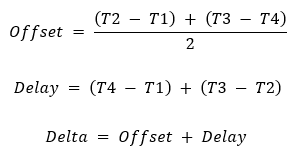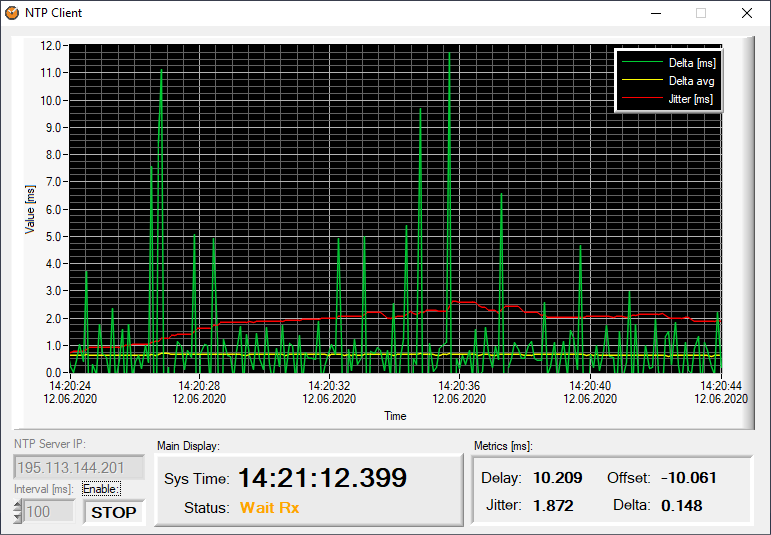# NTP-Client
**Repository Path**: jimmygodchen/NTP-Client
## Basic Information
- **Project Name**: NTP-Client
- **Description**: No description available
- **Primary Language**: C++
- **License**: WTFPL
- **Default Branch**: master
- **Homepage**: None
- **GVP Project**: No
## Statistics
- **Stars**: 0
- **Forks**: 0
- **Created**: 2025-08-19
- **Last Updated**: 2025-08-19
## Categories & Tags
**Categories**: Uncategorized
**Tags**: None
## README
# NTP Client (Windows DLL/LIB + Console + CVI GUI)
1. [Time Synchronization via NTP](#1-Time-Synchronization-via-NTP)
2. [NTP Client Library (C++ DLL)](#2-NTP-Client---Library-C++-DLL)
2.1 [Description](#Description)
2.2 [C++ interface](#C++-interface)
2.3 [C interface](#C-interface)
2.4 [Example of Use](#Example-of-Use)
3. [NTP client - Graphical Interface (CVI)](#3-NTP-client---Graphical-Interface-CVI)
## 1. Time Synchronization via NTP
NTP has been used to synchronize time in variable response networks since
1985 and that makes it one of the oldest Internet protocols. Uses UDP
OSI layer 4 protocol and port 123. By default, it achieves an accuracy of 10 ms to 200
µs, depending on the quality of the connection.
NTP uses a hierarchical system called "*stratum*". Server of type *stratum* 0
obtains the most accurate time, for example, from a cesium clock, but is not intended for
time distribution to the network. This is done by the server of type *stratum* 1, which it receives
time from *loss* 0. Then there are servers *stratum* 2 to 15, which always
they get the time from the parent server and their number basically shows
distance from the reference clock.
The NTP algorithm begins by sending a defined packet (RFC 5905), respectively
datagram, from client to server. The most important information transmitted by this packet
are client mode (NTPv4), *stratum* local clock, accuracy of local clock,
and especially the time **T1**, which indicates the time of the local clock at the time the packet leaves to
networks. After the NTP server receives the packet, the server writes the time **T2** to it, which
indicates the current time on the server clock and just before sending the time **T3**, which
indicates the time the packet leaves back to the network. After receiving the packet by the client, it is finally
writes the last time **T4**, which indicates the arrival back to the client. if they are
these times are measured accurately, it is enough to calculate the two resulting ones thanks to the formulas below
values. **Offset**, which symbolizes the shift of the client clock from the clock on the server and
**Delay**, which represents the delay of the packet passing through the network, which can be due
switches and network technologies are highly variable. The sum of these values then
represents the final shift of the local clock, which should ideally be
equal to zero.

## 2. NTP Client - Library (C++ DLL)
### 2.1 Description
I developed a simple and single-purpose library in C ++ in the environment
Microsoft Visual Studio 2019. I only relied on the official RFC specification
5905. The library is currently designed for Windows NT because it uses Win32
API for reading and writing system time and *Winsock* for UDP communication. However
in the future it is not a problem to extend it with directives \ #ifdef eg with POSIX
*sockets*.
Because the library contains only one **Client** class, the class diagram is
unnecessary.
```cpp
class Client: public IClient
```
The library has only two public methods, **query** and
**query_and_sync**.
```cpp
virtual Status query (const char* hostname, ResultEx** result_out);
virtual Status query_and_sync (const char* hostname, ResultEx** result_out);
```
Query is the core of the whole library. At the beginning of this method, a UDP is created first
packet, it is filled with the current values ??I mentioned in the first chapter and
sends it to the NTP server. Upon arrival, he completes the time T4 and performs the calculation, according to
formulas from the first chapter. Times are represented by the time_point class from the library
std :: chrono with resolution to nanoseconds (time **t1**) or class
high_resolution_clock (time **t1_b**).
```cpp
typedef std::chrono::time_point time_point_t;
time_point_t t1 = std::chrono::time_point_cast(std::chrono::system_clock::now());
auto t1_b = std::chrono::high_resolution_clock::now();
```
This combination is because the times in the first formula (offset) must be
absolute. These are the times **T2** and **T3** that came from the server. therefore not
use high_resolution_clock, in the second formula (delay) it is then possible to read **T1**
from **T4** use relative times, which can be obtained using high_resolution_clock.
The following formulas show the calculation using this approach, all units
variables are nanoseconds.
```cpp
double offset = [(T2 - T1) + (T3 - T4)] / 2
double delay = (T4b - T1b) - (T3 - T2)
```
By summing the values *offset* and *delay* we get *delta*, ie the value by which
adjust the local system clock. However, this only applies if the latter is used
public methods **query_and_sync**, the first mentioned will only communicate with
server and calculation.
Resulting calculated and obtained values, including *jitter* (stability indicators
network connection) is returned to the user either in the Result structure that is used for
classic C interface, or in the class ResultEx, which, unlike the first contains
time represented by class time_point_t, as opposed to time represented by classical
TimePt structure with *integers*.
```cpp
struct Result
{
struct TimePt time;
struct Metrics mtr;
};
```
```cpp
class ResultEx
{
public:
time_point_t time;
Metrics mtr;
};
```
This achieves the compatibility between C and C ++, which is required for a dynamic library.
If the user uses the library directly from C ++, it is more convenient to work with time
represented by the time_point_t class, otherwise there is no choice but to use it
structure.
```cpp
struct TimePt
{
int tm_nsec;
int tm_usec;
int tm_msec;
int tm_sec;
int tm_min;
int tm_hour
int tm_mday;
int tm_mon;
int tm_year;
};
```
```cpp
struct Metrics
{
double delay_ns;
double offset_ns;
double jitter_ns;
double delta_ns;
};
```
Error states are returned as *enumerator* Status, where 0 means success
(similar to POSIX) and anything else is a bug.
```cpp
enum Status : int16_t
{
OK = 0,
UNKNOWN_ERR = 1,
INIT_WINSOCK_ERR = 2,
CREATE_SOCKET_ERR = 3,
SEND_MSG_ERR = 4,
RECEIVE_MSG_ERR = 5,
RECEIVE_MSG_TIMEOUT = 6,
SET_WIN_TIME_ERR = 7,
ADMIN_RIGHTS_NEEDED = 8
};
```
In addition, the library contains several static stateless methods to facilitate the work
programmer, used primarily to format results and convert types.
### 2.2 C++ interface
The standard library interface for use with object-oriented languages is in
form *interface*, which exposes the two main public methods described above
**query** a **query_and_sync**. The interface is only a macro for the struct type,
of course you could use a proprietary MS **__interface**, but most of the time it gets better
stick to proven and compatible things.
```cpp
Interface IClient
{
virtual Status query(const char* hostname, ResultEx** result_out) = 0;
virtual Status query_and_sync(const char* hostname, ResultEx**result_out) = 0;
virtual ~IClient() {};
};
```
### 2.3 C interface
The interface usable for DLL calls must be compatible with classic ANSI C,
instead of classes, it is necessary to use the classic C OOP style, namely functions, structures and
*opaque pointers*. These functions must then be exported using the EXPORT macro,
which is a macro for **__declspec (dllexport)**. It is also necessary to set adequate
calling convention, in our case it is **__cdecl**, where the one calling as well
cleans the tray.
The **Client__create** function creates a library instance, which is represented
pointer, or macro, HNTP, which in the context of Windows is called
*handle*.
```cpp
typedef void* HNTP;
```
Other functions, such as **Client__query** or **Client__query_and_sync**
they take this indicator as the first argument. The rest is very similar to C++
interface, however one difference it has. Instead of delete, it must be called at the end
**Client__free_result** and **Client__close**.
```cpp
extern "C"
{
/* object lifecycle */
EXPORT HNTP __cdecl Client__create(void);
EXPORT void __cdecl Client__close(HNTP self);
/* main NTP server query functions */
EXPORT enum Status __cdecl Client__query(HNTP self, const char* hostname, struct Result** result_out);
EXPORT enum Status __cdecl Client__query_and_sync(HNTP self, const char* hostname, struct Result** result_out);
/* helper functions */
EXPORT void __cdecl Client__format_info_str(struct Result* result, char* str_out);
EXPORT void __cdecl Client__get_status_str(enum Status status, char* str_out);
EXPORT void __cdecl Client__free_result(struct Result* result);
}
```
### 2.4 Example of Use
You must have *runtime* **vc_redist** (2015-19) installed to run. Code
it is at least partially annotated and perhaps even clear. I tried to make it
use trivial. A client instance is created, the *query* function is called, and it terminates
the client. This can be done in an infinite loop with a defined interval,
to ensure constant time synchronization. The following lines are excluded
from a console application that serves as an example of use.
```cpp
enum Status s;
struct Result* result = nullptr;
HNTP client = Client__create()
s = Client__query_and_sync(client, "195.113.144.201", &result);
Client__free_result(result);
Client__close(client);
```

## 3. NTP client - Graphical Interface (CVI)
I used the dynamic library in the LabWindows / CVI environment to create
graphical interface of the NTP client, which is periodically called from its own thread. On
graph we then see the green delta value (the current difference of the local clock from
server), its diameter in yellow and *jitter* in network communication in red. To run
**CVI Runtime 2019** is required.

